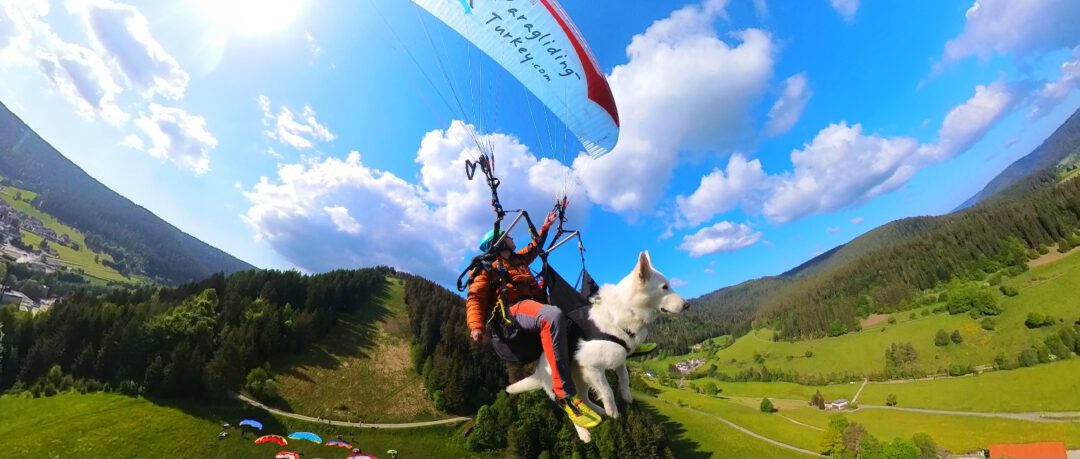Valuable tips for flying with your beloved furry friend
Since we’ve already received a few inquiries about this: No – we don’t fly with others’ dogs as passengers. – Even if you’d love to treat your furry friend to this experience.
Dog as a Passenger
Yes, I love flying with our white German Shepherd “Ouzo” and he’s incredibly happy when he gets to fly with me again. But aside from tons of treats, it took a lot of time and effort to get this far with him. Last but not least, all of this was only possible because Ouzo has an unshakeable bond of trust with us in all our sessions and generally participates in everything very reliably and happily.
Simply bringing a foreign dog along here isn’t possible. He has to know exactly what to do when it matters most. Above all, you should never throw a dog into such a situation without his best human friend. As a flight instructor, I know how people sometimes struggle mentally with the sudden altitude. To do that to a dog without him even knowing what’s going on or why – certainly not. And ultimately, me as pilot also need to have trust in the animal, that it will cooperate with me with goodwill under all circumstances. Because up there, we become an inseparable companion.
How did we get this far?
Ouzo grew up at the take-off site as a puppy. Flying people (including his owners, of course) and large rustling plastic bags were normal for him. Despite his curiosity, he still had to wait until he was 1 year old (after consulting with the breeder). This would ensure that his skeleton was strong enough to withstand a rough landing.
Since Ouzo, at a good 40 kg, is not a small dog that can’t simply be “taken along,” he first had to learn how to walk like a two-legged passenger. Carrying 40 kg and achieving the necessary running speed is simply not possible.
The logical consequence was to train the dog as a tandem passenger with an appropriate passenger harness.
Lesson learned
My first attempts at my original “let’s give it a try” approach failed miserably. Ouzo – an excellently cooperative dog in everyday life – naturally stopped immediately when the harness was pulled on the back (or otherwise on the leash). What is a basic requirement for a well-trained large dog in everyday life, of course, didn’t help when inflating a large tandem glider.
So, first, two weeks on the flat meadow and taught a new command with his harness on. When this command is called, he goes STRAIGHT FORWARD – no matter what’s behind him. – Eventually, even smaller car tires…
During this process, we fine-tuned his already excellent cooperation with the commands “Down, Sit, and Hold” as soon as he’s wearing the harness. Because the last thing you want is for your dog to suddenly start chasing a rabbit or something else when you’re both not ready at the launch site but are already attached to a paraglider.
After that, a few days on the practice slope before the first, initially smaller, high-altitude flights.
The most important thing to observe was that he always participated in everything with joy, of his own accord. Soon, his excitement was almost uncontrollable as soon as he saw a launch site – and certainly when his harness was unpacked. Even after landing, a relaxed and stress-free posture and behavior from the dog speaks for success and the ability to continue.
If you had to take your dog with you without this joy, that’s the moment when you have to stop, with a heavy heart. Because with all the stress you would cause your animal, it certainly wouldn’t do your relationship any favors. And an “us” with our furry friends is the only thing we want.
So, we’ve become a very good team and fly regularly. Shorter and medium-sized flights, always assessing the conditions on the progressive side to avoid any unfortunate experiences. It’s not about setting any records, but simply collecting good moments with your faithful companion. Or, as in our case, coming down the mountain together after a day of training as a flight instructor. And all of this with gratitude that we had a day together in nature and he didn’t have to stay home.
Easy gliders on the nearby 150m terrain provide a great change from the morning walk, instead of doing the 14th morning or evening walk of the week in the Autal valley right outside our front door…
Shared experiences instead of records – that’s probably the most important tip here.
Equipment
Paraglider
Of course, you need a paraglider that covers the weight range of both of you. In our case (approx. 145 kg takeoff weight), this means we are using a tandem glider. My tandem, the Fuse3 (up to 220 kg), is naturally somewhat underpowered. As a tandem pilot, this naturally translates more to “hot air ballooning” and less to dynamic flying. What helps on light days on the soaring edge naturally becomes a problem in strong winds. Hence the more progressive choice of conditions here as well.
Harness
A good harness for this project is a must. Because your dog will be lying in it for longer periods during longer flights, a simple climbing harness or abseiling harness, for example, for rescue missions, is not enough. If your dog is hanging in his harness for a good half hour, he needs something comfortable where his body rests flat without a few straps digging in. Only if your dog feels comfortable throughout the entire flight will they also have the enjoyment they need for your adventures together.
A height-adjustable harness is very helpful. It can be adjusted during takeoff so that your four-legged friend loses his footing first, giving you full control of the takeoff run. In the air, however, you can lower the harness a little to let your dog hang lower. A dog’s back is long, and otherwise you’ll be sitting on his back the entire flight, pushing him down, preventing him from lying comfortably and balanced in the harness. Of course, pull it back up before landing so that the pilot’s feet touch the ground first and can absorb the initial landing energy.
Hot tip: I didn’t think of that at the time, which is why Ouzo’s harness is missing a mounting element for a vario. Have a simple Velcro plate incorporated into it!
Special thanks to Flugsau.ch, who provided expertise and support and made Ouzo a custom-made harness.
Goggles
For anything where you expose your dog to wind for an extended period, goggles are necessary to protect his eyes. We’re currently in the process of getting him used to them. There are days when Ouzo is crazy about them, and there are days when he refuses them. Here, too, patience is the key, and getting used to it without any time pressure is the key to success.
Other
Always have enough of his favorite vacuum-packed treats in his harness. So that even after three weeks of not flying, he doesn’t pull dry chewing gum out of his mouth.
Beyond that
Legally, all of this is a very thin sword. Yes, of course, you have to stay within the total weight of your paraglider. How the total weight is determined isn’t specified anywhere. In German law, a dog is essentially considered an object. The assumption is that you have to carry the equipment, such as a vario, water, clothing, etc. Whether a dog can be included in this – hmm…
A tandem is generally approved as a two-seater, and a dog is not considered a person. And yes, if you exceed the weight range of a licensed solo pilot, you can also fly a tandem glider as a solo pilot. Whether that also counts towards carrying 40 kg of extra weight – hmm…
When flying tandem, you always rely on the cooperation of the passenger. If an accident, e.g., during takeoff, is caused by a dog attached as a passenger suddenly chasing a rabbit and a third party is injured, that will certainly be exciting. Because illogical behavior can never be ruled out in an animal. – hmm…
As far as I know, there are no court decisions on any of these issues yet. And if there ever is, it will certainly be exciting… Until then, be aware that if you have any doubts, you’re probably treading on very thin ice.
So, as a pilot and your dog’s best friend, think this through carefully. And don’t lose the fun of what’s probably your dog’s greatest adventure yet!

